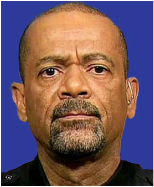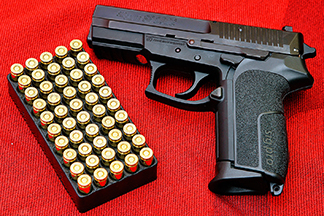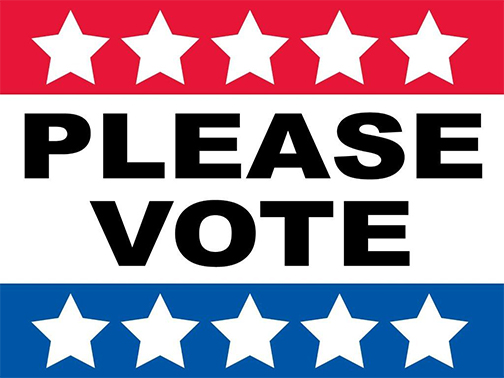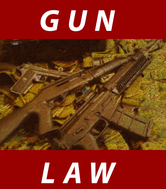|
Sheriff David Clarke's is seeking a 50% tax levy increase to fund a Sheriff's Department expansion that would include 206 additional full-time positions. Clarke's requested property tax increase is a stunning $28.7 million, up 50% from the $57.3 million levy for this year. The figures are adjusted to reflect changes in 2017 budgeting methods. Clarke and the deputies' union are fresh off a defeat in the State Court of Appeals over whether Clarke has the right to appoint as many deputies as he feels is necessary. Clarke and the union argued he did; the Appeals Court disagreed.
Clarke's budget request is sure to fuel the forever feud between him and County Executive Chris Abele. The two have clashed over many things, including the Sheriff's Department budget. The 206 new full-time equivalent positions Clarke wants next year would increase FTE staffing to 913, a 29% increase from the 707 FTEs authorized this year. "This budget seeks to remedy staff shortages created by previous years' budgets, requiring excessive amounts of overtime that has resulted in overworked, tired, and stressed sworn officers and CO staff on the job and at home," the Sheriff's Department said in its budget request. Said Steven R. Kreklow, Abele's performance, strategy and budget director: "I really can't say anything at this point other than we're reviewing the request from the Sheriff's Office and will be discussing this and other departmental budget requests with the County Executive over the next month or so." Wisconsin’s state-level judiciary is the sixth whitest in the country, according to a new study. And among states with at least 100 judges, Wisconsin is dead last in racial diversity among state judges. Not so coincidentally, according to another new study, Wisconsin's black incarceration rates are more than 11 times that for whites, the second-highest disparity rate in the nation. The report on judges, "The Gavel Gap: Who Sits in Judgment on State Courts?" reports that only 5% of the 264 Wisconsin judges considered are non-white. Nationally, 20% of judges are people of color, four times the Wisconsin rate. Wisconsin's judicial diversity lags behind other Midwestern states including Minnesota (299 judges, 15% judges of color), Michigan (257 judges, 15% judges of color), Ohio (416, 9%), Illinois (436, 27%), Indiana (129, 12%), and Iowa (127, 6%). And worse, less than one percent of Wisconsin judges are non-white women, according to the report. That is better than only the seven states – Alaska, Maine, New Hampshire, North Dakota, Rhode Island, Vermont, and West Virginia – that have no women judges of color. Women as a whole are underrepresented in the Wisconsin state judiciary, according to the report. Some 50% of the state’s population is women, but just 20% of judges are. Nationally, women of color make up 8% of state-level judges and women account for 30% of state judges. Men of color account for 4% of Wisconsin judges and 12% nationally. Gov. Scott Walker recently released the names of the three finalists for the State Supreme Court seat held by David Prosser, who is retiring – all three are white males. If Wisconsin refuses to elect or appoint minority judges to the bench, it has no problems sending minorities to prison, according to "The Color of Justice: Racial and Ethnic Disparity in State Prisons." Nationally, African-Americans are sent to state prisons at a rate 5.1 times that whites are. In Wisconsin, blacks are imprisoned at 11.5 times the rate that whites are. Hispanics are incarcerated in Wisconsin at 2.6 times the rate whites are, the fourth highest discrepancy level in the country. Nationally, on averages, Hispanics are locked up in state prisons at a rate 1.4 times that whites are incarcerated.
The authors of the judicial study, Tracey E. George, a law and political science at professor at Vanderbilt University, and Albert H. Yoon, a law and economics professor at the University of Toronto Faculty of Law, said their findings "demonstrate that we need a better process for developing a pipeline of women and minorities to serve as judges. Our courts must be representative in order to fulfill their purposes. Our laws are premised in part on the idea that our courts will be staffed by judges who can understand the circumstances of the communities which they serve." And Ashley Nellis, a senior research at The Sentencing Project and author of the racial disparity report, recommended, among other things, "adequate and regular training on the role of implicit, unchecked bias by key decisionmakers in the criminal justice system." "While open expression of negative views about people of color, as well as overt discrimination, has declined significantly in many areas of American society (largely attributable to successful civil rights laws and campaigns), some convincingly argue that this overt discrimination, especially against African Americans, has transformed into implicit bias, but with similar disparate results," she wrote. "Implicit bias trainings can make people aware of these temptations, and this awareness can minimize racially influenced trigger responses in the future," she said. The State Department of Justice has quietly dropped the maximum 50:1 student/teacher ratio it established for firearms training required to qualify for a concealed weapons permit, according to state emergency rules rules distributed Monday. That means a person can be fully qualified to carry a concealed weapon by attending a class with 1,000 other people. Actual shooting experience not required. "The legality of the 50:1 requirement is being challenged in pending litigation," DOJ said in a statement explaining the decision. "In the course of that litigation, DOJ has determined that the 50:1 requirement is not enforceable under existing law and should be repealed." The department already has stopped enforcing the class size limit, which was established by rule, the DOJ statement said. "The public welfare requires formal repeal of the 50:1 requirement by emergency rule in order to make it clear to the public that the requirement is no longer being enforced and to promptly resolve the pending litigation with the least burden and inconvenience to the Court and the parties and with the least litigation expense to the people of the State of Wisconsin," the statement said. Gov. Scott Walker approved repealing the class size limit. Concealed Carry, Inc. was the organization challenging the limit in court. DOJ said in its statement the state law allowing Wisconsin residents to carry concealed weapons specifically prohibited the department from "imposing conditions, limitations, or requirements on the issuance of a CCW license that are not specifically provided for" in the statute. Below is the rule. That language DOJ is eliminating is in bold. TEXT OF THE PROPOSED PERMANENT RULE SECTION 1. Jus 17.03 (8) is amended to read: Jus 17.03 (8) "Instructor-led" means training that is conducted face-to-face individually or in groups with an instructor-student ratio that does not exceed 50 students per instructor and in which instructors actively guide students through each lesson, answer questions, facilitate discussion, and provide feedback on activities and assignments. Learner-led or self-directed learning — the delivery of learning experiences to independent learners who lead and manage their own experience, delivered via web pages, multimedia presentations, computer applications, online presentations, or similar methods — is not instructor-led. The emergency rule is effective until Sept. 16. Stay tuned for further challenges. The concealed carry statute also does not specify in-person instruction. Photo by By Augustas Didžgalvis - Own work, CC BY-SA 3.0, https://commons.wikimedia.org/w/index.php?curid=22909218 We've had State Supreme Court Justice David Prosser allegedly grab Justice Ann Walsh Bradley by the neck. We've had Justice Michael Gableman and Justice Rebecca Bradley leave oral arguments early to speak at a political gathering. And now we have the revelations of R. Bradley's college rantings.
These type of activities do not fit neatly into the American Bar Association's idea of judicial temperament. Among the qualities which comprise judicial temperament are patience, open-mindedness, courtesy, tact, firmness, understanding, compassion and humility. Because the judicial temperament requires an ability to deal with counsel, jurors, witnesses and parties calmly and courteously, and the willingness to hear and consider the views of all sides. It requires the ability to be even-tempered, yet firm; open-minded, yet willing and able to reach a decision; confident, yet not egocentric. Because of the range of topics and issues with which a judge may be required to deal, judicial temperament requires a willingness and ability to assimilate data outside the judge's own experience. It requires, moreover, an even disposition, buttressed by a keen sense of justice which creates an intellectual serenity in the approach to complex decisions, and forbearance under provocation. Judicial temperament also implies a mature sense of proportion; reverence for the law, but appreciation that the role of law is not static and unchanging; understanding of the judge's important role in the judicial process, yet recognition that the administration of justice and the rights of the parties transcend the judge's personal desires. Judicial temperament is typified by recognition that there must be compassion as the judge deals with matters put before him or her. Factors which indicate a lack of judicial temperament are also identifiable and understandable. Judicial temperament thus implies an absence of arrogance, impatience, pomposity, loquacity, irascibility, arbitrariness or tyranny. Judicial temperament is a quality which is not easily identifiable, but which does not wholly evade discovery. Its absence can usually be fairly ascertained. Maybe the ABA meant everywhere but Wisconsin. State and local law enforcement agencies will lose millions of dollars per year under the US Department of Justice's decision to end the practice of sharing with smaller governments the loot grabbed through federal forfeitures.
In Wisconsin, the Department of Justice will be the biggest loser -- it received $1.6 million of the total $4.6 million received by state agencies in 2014, according to a federal report. The Milwaukee Police Department is next on the hit list. It got a total of $574,211. But no more, at least for now. The DOJ announced last week that it is suspending the program, called the "equitable sharing" program, because of its own financial difficulties, according to the Washington Post. The program's budget took a $1.2 billion hit. While information about what each state law enforcement buys with its "equitable share" is not available, the Milwaukee Police Department supplies its plan for the next year to the Common Council. In September, the city's federal forfeiture fund balance was $1.1 million, Police Chief Edward Flynn wrote in a letter to the council. Spending plans included: Taser lease and expansion -- $257,000 -- Lease costs for 130 tasers and purchase of 150 additional tasers. Replace generator at District 4 -- $120,000. Travel/training for officers -- $110,000. Automated Fingerprint ID System upgrade -- $16,000. Bicycle patrol -- $15,000. Cell phones -- $25,000 -- for use in the field. Canine unit -- $6,000 -- funds food, medical care and boarding for three dogs. Without the dogs, the letter said, the department will be "less successful in its attempt to secure ferally seized forfeiture funds." Administrative and miscellaneous expenses for command -- $90,000. The federal program can be quite profitable for state and local law enforcement, as it allows them to keep up to 80% of the value of seized property; state asset seizure law allows them to keep generally just 50% to 70%. The difference, according to some, encourages law enforcement to use the federal asset forfeiture program whenever possible. There's an additional bonus -- people losing their property don't need to be convicted of any crime. There is a bipartisan proposal in the State Legislature to tighten up state asset forfeiture law and requires law enforcement to turn over to the state school fund proceeds from the sale of all forfeited property. It would also limit law enforcement's ability to use the federal forfeiture route. The bill is opposed by the Wisconsin Chiefs of Police Association and the Wisconsin Sheriffs and Deputy Sheriffs Association. Gun toters who have Wisconsin concealed carry permits nestled next to their firearms will lose their right to carry concealed in Virginia as of Feb. 1. Attorney General Mark R. Herring, a Democrat, decided to end recognition of concealed carry permits issued by Wisconsin and 24 other states because their concealed carry laws are weaker than Virginia's, according to the New York Times. (Wisconsin does not now recognize Virginia's permits.) Virginia's concealed carry law has numerous disqualifiers "designed to prevent potentially dangerous or irresponsible individuals from being able to lawfully conceal handguns," Herring's office said in a statement. States losing Virginia concealed carry recognition do not have similar conditions. Folks disqualified from Virginia concealed carry include those who:
 Securus, a prison and jail phone service provider under scrutiny for large-scale violations of attorney-client privilege, is a major player in the Wisconsin corrections industry, according to the firm's own website. The Dallas-based firm was the target of a hack that revealed the records of more than 70 million phone calls, according to The Intercept, the website that broke the story. "Particularly notable within the vast trove of phone records are what appear to be at least 14,000 recorded conversations between inmates and attorneys, a strong indication that at least some of the recordings are likely confidential and privileged legal communications — calls that never should have been recorded in the first place," The Intercept reported. It quoted David Fathi, director of the ACLU’s National Prison Project: “This may be the most massive breach of the attorney-client privilege in modern U.S. history, and that’s certainly something to be concerned about.” Securus' list of Wisconsin clients is extensive and includes about 80 jails, sheriff's departments, and state prisons and correctional facilities. The full list is available here. |
Donate
Help WJI advocate for justice in Wisconsin
|
Copyright © 2024 Wisconsin Justice Initiative Inc.
The Wisconsin Justice Initiative Inc. does not endorse candidates for political office. The Wisconsin Justice Initiative Inc. is a 501(c)3 organization.
The Wisconsin Justice Initiative Inc. does not endorse candidates for political office. The Wisconsin Justice Initiative Inc. is a 501(c)3 organization.






 RSS Feed
RSS Feed